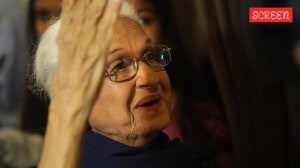Getting back on track on the 5.50 Borivali Fast
For a city derailed by terror, nothing would be a more apt metaphor for getting back on the rails than stepping into the 5.50 Borivali Fast at Churchgate station.

For a city derailed by terror, nothing would be a more apt metaphor for getting back on the rails than stepping into the 5.50 Borivali Fast at Churchgate station. This is the train that took the first of the seven blasts yesterday.
The wreckage is gone, the compartments have been replaced, the only reminder of 7/11 on this 7/12 evening the empty spaces in the train and on the platform. The unmistakable signs of a nervous city taking only a tentative step towards normalcy. Right from five minutes before departure:
• 5.45 pm, Churchgate: T Shailendra, a state government employee, is returning home first-class. ‘‘Perhaps you sense a disquiet today simply because there’s no need to jostle,’’ he says. The crowd in his compartment is a quarter of what normal is, the prize window seats not taken.
Outside, the shoe-shine boys—‘‘not much dhanda (business) today’’—are tap-tapping with their shoe-brushes, but one eye is on the sniffer dog that passes them in a blur. The whistle blows and, one eye on the laptop bag lying on the overhead rack, Shailendra begins his journey home—safe.
• 6.00 pm, Grant Road: People step out, people step in. They huddle at the doorways, to chat. Death on Mumbai’s railway tracks doesn’t make the headlines everyday, the conversation takes off. The tracks claim an average eight Mumbaiites every day—jaywalkers, workers, the unidentified. And all three are back where they are every day.
‘‘So fragile, no?’’ says Bharat Kothari, a diamond trader, when asked what happened to him yesterday. ‘‘That’s life—a matter of seconds one way or the other.’’
He’s not being philosophical—38 of his colleagues from the diamond bourse were among the 150 killed until last night, up to 185 this evening, still counting. All the 38 were passengers on all the seven trains, going home from Charni Road to Andheri or Vile Parle. Fellow-trader Anup Kubrekar shakes his head as he listens to Kothari, grumbles about railway service, then goes back to take the wind in his face.
• 6.16 pm, Dadar: This is The Busiest Station, The Most Reliable Station, never failing to link passenger to train. By now, all seats are taken, the familiar has returned. Unlike Kothari or Kubrekar, people are not standing by choice.
One of those seated is an investment banker, he doesn’t want to tell his name. In still-spotless white, he extracts his Blackberry, a Su-Doku puzzle and a gold-plated pen. Ipods, Walkmans, newspapers emerge—those who rarely get a seat are enjoying the luxury. Yesterday’s headlines is just that—yesterday’s headlines.
• 6.24 pm, Mahim: Faces turn to the windows, fingers hold the bars, this is where the blast tore the roof, an image still making it to cellphone photo galleries. In the excitement, it’s easy to skip the gravity of the hour—it was precisely 24 hours ago that this compartment of another rake was exploding at Bandra.
But in a city that hams its way into every innovation possible, insurance salesman Manoj Sinha has an idea. ‘‘Compulsory insurance, the premium tweaked into your season ticket.’’ Sinha is an insurance consultant and his take on Maximum City’s frequent trysts with tragedy: ‘‘Globally, it’s innocents who die. But our lives are fragile by our choice.’’
• 6.27 pm, Bandra: This is where the first blast occurred, its echo heard across the nation. As the train stops, men gather their laptops and lunchboxes, no one’s craning any neck to see what happened yesterday. There was a drizzle yesterday, today it’s dry. It’s a much smoother walk across the bridge, into Bandra this evening. Yesterday, there was death here; today it’s life.


- 01
- 02
- 03
- 04
- 05




























